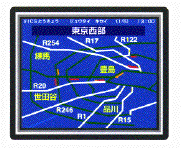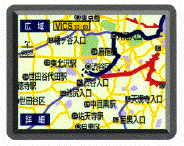
Text display type.
TRAFFIC INFORMATION RELAY SYSTEM:
New System Provides Prompt, Detailed Information
on Road Conditions
JUNE 13, 1996
Expectations are running high that a new service providing detailed, up-to-the-minute information on traffic jams in and around Tokyo will revolutionize driving on what many say are some of the world's most congested roads. The Vehicle Information and Communication System, launched on April 23, can be accessed with car navigation systems.
Visual and Textual Data
Three levels of information are offered. The first comprises written data on traffic tie-ups over a large geographical area. A message of this sort might inform drivers that "Traffic backed up five kilometers on the Tokyo-bound section of the Tomei Expressway around Kawasaki."

Text display type.

Simple graphic display type.
The second includes simple diagrams showing the location of traffic jams and accidents on expressways. The last comprises maps with information on tie-ups and accidents on other major roads. Transmissions of conditions on roads under construction and other areas where traffic restrictions are in place, and even data on parking lot vacancies, are also available.

Map display type.
(Graphics: VICS Center)
Information may picked up by car navigators from FM multiplex broadcasts or radar-wave and infrared beacons set up at regular intervals along the roads. Drivers simply turn on their car navigators and choose the type of information desired. No fees are charged for use of the system.
VICS has won the praise of metropolitan area drivers. Many people have expressed appreciation for the up-to-the-minute information on road and traffic conditions, which they say goes far beyond that provided by electronic road signs and radio reports.
Others comment that they can now avoid the annoyance that comes with traffic jams and long searches for parking spaces. One driver speculated that the system would help prevent traffic accidents because people setting out with the necessary road information would drive more leisurely.
The Wave of the Future
The new system is operated by the VICS Center, an organization established by automobile, electric appliance, and other manufacturers with the backing of the National Police Agency, the Ministry of Posts and Telecommunications, and Ministry of Construction. A separate receiver and antenna are necessary to receive VICS information on older car navigation units. Models with a built-in receiver began appearing on the market in May.
Though now limited to Tokyo, the service is scheduled to be launched in Osaka by March 1997, and in Aichi, Kyoto, and six other prefectures within the next few years. The service area will gradually be expanded to cover the whole country.
The VICS Center predicts that in 20 years, about 20% of all cars will receive VICS data.